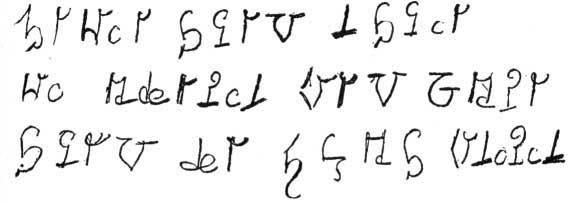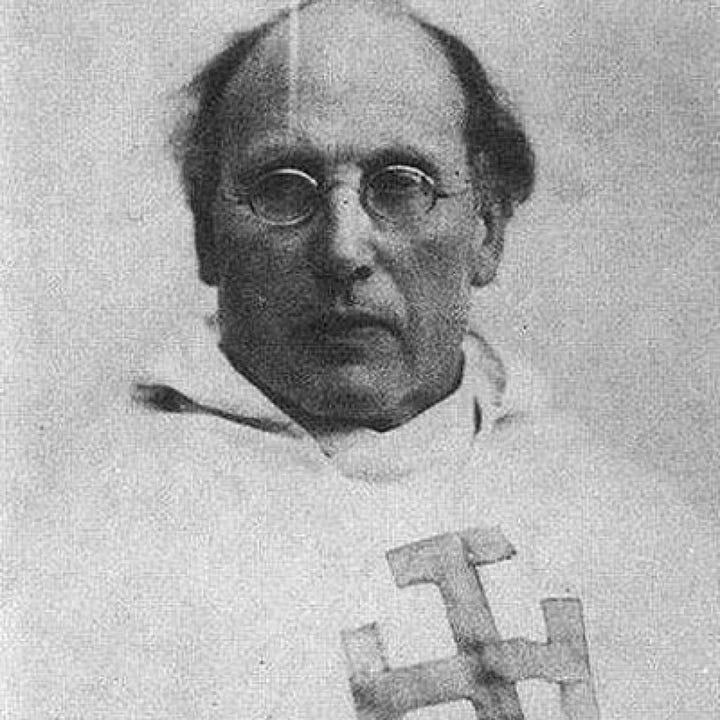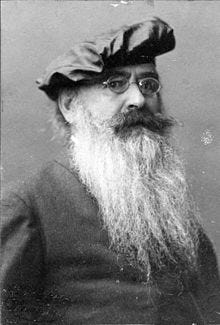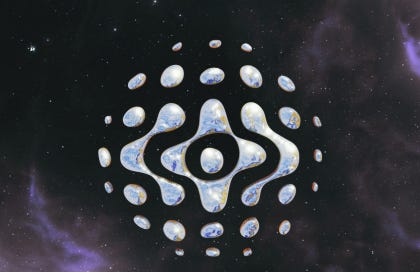Cowgirls, cowboys, cowthems — welcome back to another edition of Snake Oil, a newsletter that gabs about grift, misinfo, propaganda, and other odd things being sold to us on the World Wild Web.
Today we have slithered into the inbox with a part TWO on Starseeds, “lightworkers,” and the occult eugenics of the 19th century movement called Theosophy. If you missed part one (or need a refresher), make sure to give it a read — we are doing some Serious Historical Research here to explain why people on TikTok think they’re angelic aliens called “Starseeds.”
Our journey began in the 19th century Russian empire with Madame Blavatsky and the birth of the Theosophical movement. Her spiritual quackery served as a mirepoix for a number of ideologies and movements in the 20th century, New Age religions and Nazi occultism to name a relevant two, whose influences mixed with the birth of space exploration, the psychedelic era, and the burgeoning genre of speculative fiction—laying the groundwork for TikTok aliens.
Starseeds is one among a number of “conspiritual” (conspiracy and spirituality) communities that are growing online in the 2020s. It is a trend that may well be a path to radicalization into right-wing and cult-like movements online including Red Pill communities and QAnon.
One example of an online “conspiritualist” is the QAnon Shaman (a.k.a. Jacob Chansley), the fur-hatted-and-horned participant of the Jan. 6 insurrection. Chansley has referred to himself as a “multidimensional being,” believes that America is controlled by a reptilian deep state, and once had a YouTube channel and Facebook page called “Star Seed Academy” in which he posed as a spiritual guru.
The intermingling of these two seemingly separate realms— tin foil hat-wearing conspiracists and woo-woo mystical types—has been going on long before the internet age. As Asprem and Dyrendal write in a paper in the Journal of Contemporary Religion: “Conspirituality can be viewed as a predictable result of structural elements in the cultic milieu and […] its roots stretch deep into the history of Western esotericism.”
Whether a believer in Q or in angelic aliens, the two cohorts have several key elements in common: members see themselves as seekers of truth, believe in soteriological (i.e. salvation) narratives, and harbor suspicion towards establishment or orthodox knowledge in favor of “stigmatized” knowledge.
To take a look at this conspiritual history—specifically as it relates to Starseeds—let’s spin the clock back to the fin de siècle. The 20th century was dawning, sparking anxieties in the West about cultural decadence, modernity, and technology. As a kind of world-weariness hung over Western empires-in-decline, a sober-eyed gaze that accompanied the dominant trends of realism and naturalism, a number of aesthetic and spiritual groups sprung up amongst the urban literati and artistic circles, seeking escape from society through dreams, fantasy, and aesthetics (i.e. making “art for art’s sake).1
And though space travel was not yet possible, individuals from different fields and persuasions turned their eyes skyward, seeking answers.
On the astronomy front, new visions of the cosmos were emerging. In 1888, astronomer James Edward Keeler observed a gap between Saturn’s rings at the Lick Observatory in the Diablo Range of California. Six years later, in Flagstaff, Arizona, Percival Lowell built an observatory, determined to find canals on the surface of Mars—a feature speculated by French counterpart Camille Flammarion, an astronomer-cum-mystic who believed in the existence of alien life on the red planet and attributed its color to plant life on its surface.
A combination of these factors—cosmological discovery and fictional worlds—fueled interest among the general public about alien life.
Occultists and spiritualists of the time were no exception.2 In turn-of-the-century London, Annie Horniman and Frederick Leigh Gardner, two members of the secret, magical society called The Hermetic Order of the Golden Dawn, claimed to be astral projecting to other planets and encountering angelic beings. Horniman (who went by the Adept name Fortiter et Recte) and Gardner (De Profundis ad Lucem) went on a number of astral projection journeys which took them to Saturn, Jupiter, Mars, Mercury, Venus, and the Sun in the year 1898.

Recounting one journey to the Sun, “F.E.R.” as Horniman was referred to in shorthand, wrote about an encounter with angelic aliens: “We saw a brightness before us & in time it formed into a glorious gold and orange angel with out-stretched wings & fair hair…We now came to another angel clothed in a robe like diamonds with orange color shining through.”
Meanwhile in Switzerland, a shopkeeper-turned-medium named Catherine-Elise Müller was also claiming to make extraplanetary travels. Adopting the pseudonym Hélène Smith, she reported making psychic visitations to Mars, was able to speak “Martian,” and also received visions of her past lives in India and France, as recorded in a popular book at the time by French psychologist Théodore Flournoy. Her glossolalia even extended to handwriting. In her trance-like state she would engage in so-called “automatic” writing, or psychography, recording Martian words onto the page.

These are more of the obvious descendants of Blavatsky’s mystical practices. But it wasn’t just the spiritualists weaving new cloth from theosophical threads.
Aryan cults and German völkisch circles that emerged in Austria in the late 19th century (and later spread to Germany through to the 1930s) drew upon Theosophy to form what is known as Ariosophy. Literally meaning “wisdom of the Aryans,” the racist occult ideology was created to justify “Aryan-Germanic” racial superiority. Two leading figures in this enterprise were Guido von List and Jorg Lanz von Liebenfels3, who might be described as uber-racist mythology nerds. Both had ideas that provided the basis for what is alternatively termed “esoteric fascism” or “Nazi occultism,” ideologies that combined German folklore with theosophical eugenics.
In Liebenfels’ book, titled: Theozoology, or The Science of the Sodomite Apelings and the Divine Electron, he used the Bible to spiritually justify Aryans as a superior race, claiming they were descendants of divine aliens called the Theozoa. He would go on to spew these ideas across the pages of the racist hate rag, Ostara, a publication that a young Adolf Hitler allegedly read.
Fascist supporters of Hitler went so far as to claim the führer himself was a divine being. Savitri Devi Mukherji, the French-Greek fascist and Nazi sympathizer, promoted the idea that Hitler was an avatar of the Hindu god Vishnu in perhaps one of the most mind-boggling of Blavatsky-esque remixes. Another bizarre theosophical remix was the Nazi hunt for Atlantis—a bogus, pseudo-archeological effort intended to bolster their narrative of “Aryan” superiority.


Mukherji (born Maximiani Julia Portas) was not the only one to link fascism and spiritualism. French esotericist René Kopp published stories in occult publication Le Chariot in the 1930s attributing Hitler’s power (and Napoleon and Mussolini’s ascents) to supernatural, occult forces, and referred to the three totalitarians as “masters” (a similar sound to Blavatsky’s ‘ascended masters.’)4
Two books published in 1939, Hitler et les Forces Occultes (Hitler and the Occult Forces) by French author Edouard Saby, and Hitler Speaks by Hermann Rauschning further attributed Hitler’s rise to his connections with magic and secret societies.5
There’s something to be said here about the intertwining of Western esotericism and eugenics. The mixture appears to have been a potent foundation for building ideologies and attracting adherents—whether it be a fascist or a bohemian spiritualist movement—during the early to mid 20th century.
For proto-fascists and fascists, the idea of “Aryanness” helped to construct the mythos and nostalgia of a fictional German golden age, and for spiritualists, the idea of being more enlightened marked one as being head and shoulders above the unawakened masses. Perhaps the ideas married so well because of their focus on exclusion and superiority of a particular cohort. And in an age increasingly driven by science, reason, and novel technologies, couching ideology in mysticism, in belief rather than empirical fact, allowed an element of narrative control and storytelling unaccountable to any kind of science.
It’s a formula that continued to sell in the latter half of the 20th century, albeit in new forms.6 More on that in part 3.
Thank you for reading this edition of Snake Oil and for being a part of our 689-subscriber strong community <3 Many thanks to Darcy Modica for editing and feedback on this edition.
If you’d like to toss a coin to your writer, I now have a Buy Me A Coffee page which also features a proletariat-approved Karl Marx meme :)
Formally known as the Decadent movement. Members included artists like Gustav Moreau and Fernand Khnopff; writers included Oscar Wilde, Paul Verlaine, and Charles Baudelaire.
One interesting crossover between the literary and spiritual worlds was Irish poet W.B. Yeats, who met Madame Blavatsky in London in the late 1880s and joined her circle, but was booted from the organization after conducting occult magical experiments. He later found a home in the Golden Dawn—which he left in 1900 over administrative agreements.
The secret societies they founded, the List Society (and within it, the more exclusive High Armanen Order) and the Order of the New Templars, respectively, in addition to other similar groups that formed in the final years of Kaiser Wilhelm III’s reign, can be linked by both ideas and membership to the emergence of the Nazi Party in Munich following the First World War.
More reading on this topic: https://www.researchgate.net/publication/292292306_Nazism_and_the_Occult
Interesting how belief in aliens or non-human beings both propped up Nazi figures, but was also weaponized against Jews in the form of antisemitic conspiracy theories featuring aliens and elite cabals. As Christopher Roth writes in Ufology as Anthropology: Race, Extraterrestrials, and the Occult: “There is a strong strain of anti-Semitic conspiracy theorizing that makes ufological connections.” In addition, as Theodor Adorno writes: “The appeal of anti-Semitism to insiders is its status as the ‘secret’ which explains everything and is available only to initiates. Like occultism and astrology, anti-Semitism is a paranoid projection of the ‘semi-erudite.’”
These were far from the only places these ideas cropped up—authors including Aldous Huxley, T.S. Eliot, and WB Yeats also flirted with mystical and eugenicist ideas in their works. You also have Rudolf Steiner and his development of anthroposophy, which was influenced by Theosophy. Artists like Wassily Kandinsky and Piet Mondrian were also inspired by Theosophy in their works.





